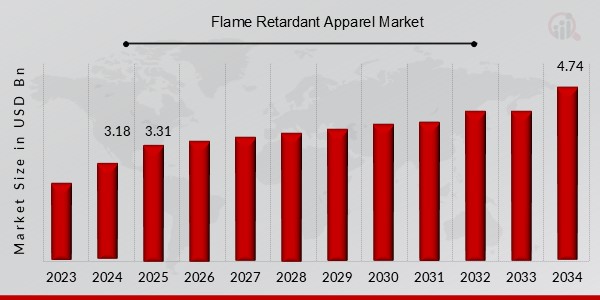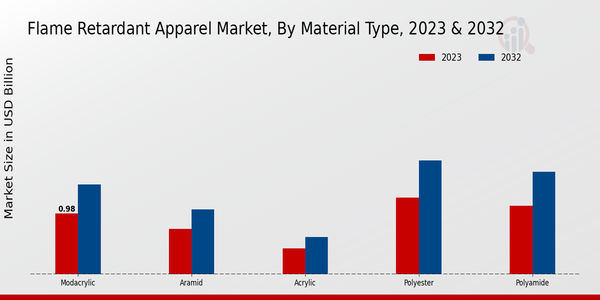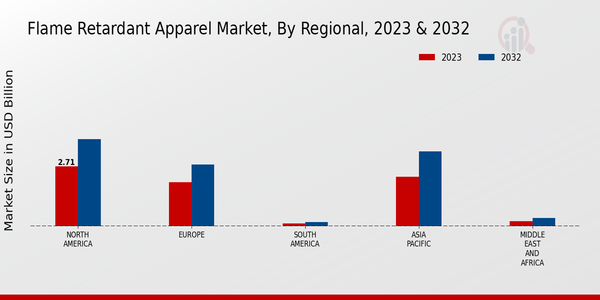Global Flame Retardant Apparel Market Overview
The Flame Retardant Apparel Market Size was estimated at 3.18 (USD Billion) in 2024.he Flame Retardant Apparel Industry is expected to grow from 3.31(USD Billion) in 2025 to 4.74 (USD Billion) by 2034. The Flame Retardant Apparel Market CAGR (growth rate) is expected to be around 4.1% during the forecast period (2025 - 2034).
Key Flame Retardant Apparel Market Trends Highlighted
The flame retardant apparel market is poised for significant growth due to increasing safety regulations and technological advancements. Key market drivers include the rising awareness of fire safety, stringent industry regulations and the need for protective clothing in hazardous occupations. Furthermore, advancements in flame retardant materials, such as meta-aramids and nanocomposites, are expanding the scope of applications for these garments.
Emerging opportunities in the flame retardant apparel market lie in the development of lightweight and breathable materials that offer superior protection. Additionally, the integration of smart technologies, such as wearable sensors and temperature regulation, is expected to enhance the functionality of these garments. Recent trends include the increasing adoption of disposable flame-retardant coveralls in healthcare and industrial settings, as well as the growing demand for customized apparel to meet specific requirements. These factors are expected to drive the continued expansion of the flame-retardant apparel market in the coming years.

Source: Primary Research, Secondary Research, Market Research Future Database and Analyst Review
Flame Retardant Apparel Market Drivers
Rising Demand for Protective Clothing in Hazardous Industries
Title: Demand for Flame-Retardant Apparel The demand for flame-retardant apparel is growing due to the increasing prevalence of hazardous environments in different industries. Workers in the oil and gas, chemical manufacturing, and firefighting industries need protective clothing to prevent severe injuries that may result from exposure to flames and other hazards. Flame retardant apparel offers an essential layer of protection, which may prevent or delay the ignition and spread of flames.
The increased knowledge of workplace safety standards and regulations also contributed to the demand for this type of protective clothing. Nowadays, many companies are more concerned about their employee’s well-being and safety.
Advancements in Flame Retardant Technologies
The Flame Retardant Apparel Market Industry is witnessing significant advancements in flame retardant technologies, leading to the development of more effective and durable materials. Manufacturers are investing in research and development to create innovative flame-retardant solutions that offer enhanced protection without compromising comfort or mobility. The introduction of new materials and technologies has expanded the range of applications for flame retardant apparel, making it suitable for a wider range of industries and applications.
These advancements have contributed to the growing adoption of flame retardant apparel, as they provide superior protection and meet the evolving needs of different industries.
Increasing Awareness of Fire Safety Regulations
Governments and regulatory bodies worldwide are implementing stringent fire safety regulations to ensure the safety of citizens and workers. These regulations often mandate the use of flame-retardant apparel in specific industries and applications, driving the demand for compliant products. The growing awareness of fire safety hazards and the potential consequences of non-compliance have prompted organizations to invest in flame retardant apparel as a proactive measure to mitigate risks and protect their employees.
This regulatory push has created a significant market opportunity for flame retardant apparel manufacturers as they cater to the increasing demand for compliant and protective solutions.
Flame Retardant Apparel Market Segment Insights:
Flame Retardant Apparel Market Material Type Insights
The Flame Retardant Apparel Market is segmented into various material types such as Modacrylic, Aramid, Acrylic, Polyester, Polyamide and Others. Each material type offers unique properties and characteristics that cater to specific end-use applications. Modacrylic is a synthetic fiber known for its inherent flame-retardant properties and high resistance to heat and chemicals. It is widely used in protective clothing for firefighters, industrial workers, and military personnel. Aramid, another synthetic fiber, is exceptionally strong and flame-resistant.
It is often blended with other materials to enhance durability and performance in high-risk environments. Acrylic, on the other hand, is a versatile material that offers flame retardancy along with moisture-wicking and anti-static properties. It is commonly used in sportswear, casual wear and home furnishings. Polyester is a popular synthetic fiber that is inherently flame-resistant and wrinkle-resistant. It is widely used in a range of applications, including protective clothing, outdoor apparel and home textiles. Polyamide, also known as nylon, is a strong and durable synthetic fiber with inherent flame retardancy.
It is commonly used in sportswear, activewear and industrial clothing. The 'Others' segment includes various specialty materials such as inherently flame-resistant cotton, wool and blends. These materials are often used in niche applications where specific properties are required. The Flame Retardant Apparel Market segmentation provides insights into the relative market share, growth potential and key trends associated with each material type. By understanding the specific properties and applications of different materials, manufacturers can optimize their product offerings and target specific end-use markets effectively.
The data on market size, growth rate, and regional distribution can assist stakeholders in making informed investment decisions and developing tailored marketing strategies.

Source: Primary Research, Secondary Research, Market Research Future Database and Analyst Review
Flame Retardant Apparel Market Application Insights
The application segment of the Flame Retardant Apparel Market is categorized into Oil and Gas Industries, Utilities, Firefighting, Transportation, Military and Defense and Others. The Oil and Gas Industries segment is anticipated to account for a substantial share of the market due to the stringent safety regulations and the need for protective apparel in hazardous environments. The Utilities segment is also expected to witness significant growth owing to the increasing demand for flame-resistant clothing among workers in power plants and electrical distribution companies.
The Firefighting segment is projected to hold a prominent position in the market due to the growing number of wildfires and industrial accidents, necessitating the use of specialized flame-resistant gear for firefighters. The Transportation segment is anticipated to gain traction as flame-retardant apparel becomes mandatory for workers in the aviation and rail industries. The Military and Defense segment is expected to contribute to the market growth due to the rising demand for protective clothing for soldiers and other personnel in combat zones.
The Others segment includes applications such as mining, construction and manufacturing, where flame-resistant apparel is essential for worker safety.
Flame Retardant Apparel Market Performance Insights
The Performance segment of the Flame Retardant Apparel Market is anticipated to exhibit robust growth over the forecast period. In 2023, the segment is projected to account for a significant share of the overall market revenue. This growth can be attributed to the increasing demand for protective clothing in various industries, such as firefighting, oil and gas and manufacturing. Flame-resistant apparel, which is designed to resist ignition and prevent burn injuries, is expected to remain a key driver of segment growth. Additionally, heat-resistant apparel, which provides protection against high temperatures, is also anticipated to contribute to the segment's expansion.
Arc-resistant apparel, designed to protect against electrical hazards, is projected to witness steady demand in the coming years. Anti-static apparel, which prevents the accumulation of electrostatic charges, is expected to gain traction in industries where static electricity poses a risk.
Flame Retardant Apparel Market End-Use Insights
The End-Use segment plays a crucial role in shaping the Flame Retardant Apparel Market. Workers, firefighters, military personnel, welders, and electrical workers represent key end-users of flame-retardant apparel, collectively accounting for a significant share of the market revenue. The demand from these industries is driven by stringent safety regulations and the need to protect workers from hazardous environments. Firefighters and military personnel require specialized flame-retardant apparel that can withstand extreme heat and flames, while welders and electrical workers need protective clothing to prevent burns and electrical hazards.
The growing number of industrial accidents and fires highlights the importance of flame-retardant apparel in ensuring worker safety. Additionally, the increasing adoption of flame-retardant materials in various industries, such as construction, manufacturing and transportation, is expected to drive the growth of the End-Use segment in the coming years.
Flame Retardant Apparel Market Regional Insights
The Flame Retardant Apparel Market is segmented regionally into North America, Europe, APAC, South America and MEA. Among these regions, North America dominated the market in 2023, accounting for a major market share. This dominance is attributed to the presence of a large number of end-use industries, stringent safety regulations, and advanced technological capabilities in the region. Europe is expected to be the second-largest market for flame retardant apparel, owing to the growing demand from various industries such as oil, gas, construction and manufacturing.
The APAC region is anticipated to witness significant growth in the flame-retardant apparel market, driven by the rising demand from developing economies like China, India and Japan. South America and MEA are expected to contribute a smaller share of the global market due to limited industrialization and lower safety regulations. Despite this, these regions are expected to show steady growth in the coming years.

Source: Primary Research, Secondary Research, Market Research Future Database and Analyst Review
Flame Retardant Apparel Market Key Players And Competitive Insights:
The Flame Retardant Apparel Market contains many players and most of them are major players in the industry who are focusing on technological and innovative advancements. Major players in the Flame Retardant Apparel Market are focused on developing lighter-weight, more durable and more comfortable flame-resistant fabrics. Partnerships and collaborations are shaping the competitive landscape and enabling companies to enhance their product portfolios and expand their geographic presence in the Flame Retardant Apparel Market. The Flame Retardant Apparel Market is likely to witness mergers and acquisitions.
Based on the capabilities of key players, the Flame Retardant Apparel Market is witnessing investments in R. Investments in R are aimed at introducing innovative products that meet high-performance standards and comply with the latest regulatory standards. The development of the Flame Retardant Apparel Market is supported by the increasing awareness of workplace safety among consumers and strict fire protection regulations on the Flame Retardant Apparel Market.
One of the major players operating in the Flame Retardant Apparel Market is DuPont. This company is offering innovative and high-quality flame-resistant fabrics such as Nomex and Kevlar. The company is focusing on developing flame-resistant fabrics that can offer outstanding protection and have a strong presence in various parts of the world. The company has innovation as its core competence and has become one of the major players in the Flame Retardant Apparel Market by developing outstanding flame-resistant technologies to protect people who work in high-risk environments in industries such as manufacturing, oil and gas, and firefighting.
Another major player in the Flame Retardant Apparel Market is Lakeland Industries, which is a manufacturer and provider of protective clothing and equipment. The company has developed flame-resistant severalties and is a company with high standards of quality with a commitment to customer satisfaction.
Key Companies in the Flame Retardant Apparel Market Include:
-
BASF
- Dow Chemical Company
- Albany International Corp.
Flame Retardant Apparel Industry Developments
-
Q2 2024: Bulwark® Protection Launches New Line of Flame-Resistant Apparel for Women in Industrial Workplaces Bulwark® Protection announced the launch of a new line of flame-resistant (FR) apparel specifically designed for women working in industrial environments, expanding its product portfolio to address the growing demand for gender-specific safety gear.
-
Q2 2024: DuPont Launches Next-Generation Nomex® Xtreme Arc for Enhanced Arc Flash Protection DuPont introduced Nomex® Xtreme Arc, a new flame-resistant fabric engineered to provide superior arc flash protection for workers in the utility and electrical industries, marking a significant product innovation in the FR apparel sector.
-
Q2 2024: Lakeland Industries Announces Opening of New Manufacturing Facility in Vietnam Lakeland Industries, a global manufacturer of protective clothing, opened a new manufacturing facility in Vietnam to increase production capacity for flame-retardant apparel and meet rising global demand.
-
Q3 2024: Honeywell Partners with 3M to Develop Smart Flame-Resistant Workwear Honeywell and 3M announced a strategic partnership to co-develop smart flame-resistant workwear integrating sensor technology for real-time safety monitoring in hazardous industrial environments.
-
Q3 2024: National Safety Apparel Acquires Enespro PPE to Expand Flame-Resistant Product Portfolio National Safety Apparel completed the acquisition of Enespro PPE, a provider of flame-resistant personal protective equipment, to broaden its offerings and strengthen its position in the FR apparel market.
-
Q3 2024: Portwest Opens New Distribution Center in Texas to Support North American Flame-Resistant Apparel Market Portwest, a global manufacturer of protective workwear, opened a new distribution center in Texas to enhance logistics and supply chain efficiency for its flame-resistant apparel products in North America.
-
Q4 2024: Carrington Textiles Launches Eco-Friendly Flame Retardant Fabric Range Carrington Textiles introduced a new range of eco-friendly flame retardant fabrics made from recycled materials, targeting sustainability-conscious customers in the protective apparel sector.
-
Q4 2024: VF Corporation Appoints New President for Workwear Division, Overseeing Flame-Resistant Brands VF Corporation announced the appointment of a new president for its Workwear division, which includes oversight of its flame-resistant apparel brands such as Bulwark and Red Kap.
-
Q1 2025: Seyntex Secures Major Contract to Supply Flame-Retardant Apparel to European Rail Operator Seyntex, a European protective clothing manufacturer, won a significant contract to supply flame-retardant apparel to a leading European rail operator, expanding its presence in the transportation sector.
-
Q1 2025: Kimberly-Clark Professional Launches Disposable Flame-Resistant Coveralls for Oil & Gas Industry Kimberly-Clark Professional launched a new line of disposable flame-resistant coveralls designed for workers in the oil and gas industry, addressing the need for single-use protective solutions.
-
Q2 2025: Arco Ltd. Announces Investment in UK-Based Flame Retardant Apparel Manufacturing Facility Arco Ltd. announced a multi-million-pound investment in a new UK-based manufacturing facility dedicated to producing flame retardant apparel, aiming to boost domestic production and reduce supply chain risks.
-
Q2 2025: Hydrowear BV Partners with Scandinavian Distributor to Expand Flame-Retardant Apparel Reach Hydrowear BV, a Dutch manufacturer of flame-retardant workwear, entered into a distribution partnership with a major Scandinavian distributor to increase its market presence in Northern Europe.
Flame Retardant Apparel Market Segmentation Insights
Flame Retardant Apparel Market Material Type Outlook
Flame Retardant Apparel Market Application Outlook
Flame Retardant Apparel Market Performance Outlook
Flame Retardant Apparel Market End-Use Outlook
Flame Retardant Apparel Market Regional Outlook
| Report Attribute/Metric |
Details |
| Market Size 2024 |
3.18(USD Billion) |
| Market Size 2025 |
3.31(USD Billion) |
| Market Size 2034 |
4.74(USD Billion) |
| Compound Annual Growth Rate (CAGR) |
4.1% (2025 - 2034) |
| Report Coverage |
Revenue Forecast, Competitive Landscape, Growth Factors, and Trends |
| Base Year |
2024 |
| Market Forecast Period |
2025 - 2034 |
| Historical Data |
2020 - 2024 |
| Market Forecast Units |
USD Billion |
| Key Companies Profiled |
BASF SENewparaDow Chemical Company, Lydall, Inc., Huntsman Corporation, Treofan Germany GmbH, Albany International Corp., Chemtura Corporation, DuPont de Nemours, Inc., Kolon Industries, Inc., Toray Industries, Inc., Teijin Limited, Solvay SA, Milliken Company, Pegas Nonwovens s.r.o. |
| Segments Covered |
Material Type, Application, Performance, End-Use, Regional |
| Key Market Opportunities |
1. Emerging applications in defense and aerospace 2. Growing demand from firefighters and industrial workers 3. Rising awareness of safety regulations 4. Advancements in flame-resistant materials and 5. Technological innovations in smart and protective apparel |
| Key Market Dynamics |
1. Growing demand for protective clothing 2. Rise in industrial accidents 3. Stringent government regulations |
| Countries Covered |
North America, Europe, APAC, South America, MEA |
Frequently Asked Questions (FAQ):
The Flame Retardant Apparel Market was expected to reach a valuation of 3.18 Billion USD in 2024.
The Flame Retardant Apparel Market is expected to grow at a CAGR of 4.1% from 2025 to 2034.
The Asia Pacific region is expected to hold the largest market share in the Flame Retardant Apparel Market.
Key applications of Flame Retardant Apparel include firefighting, welding, and oil and gas industries.
Key competitors in the Flame Retardant Apparel Market include DuPont, Honeywell, and 3M.
Major factors driving the growth of the Flame Retardant Apparel Market include increasing safety regulations and rising demand from end-use industries.
Challenges faced by the Flame Retardant Apparel Market include stringent environmental regulations and the high cost of raw materials.
Emerging trends in the Flame Retardant Apparel Market include the development of sustainable and eco-friendly flame retardant materials.
The Flame Retardant Apparel Market is expected to reach a valuation of 4.2 Billion USD by 2032.
Technological advancements are leading to the development of more effective and comfortable flame-retardant materials.
















